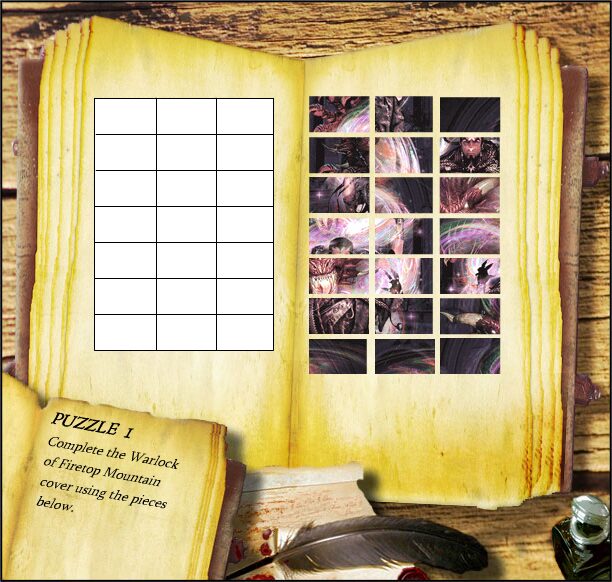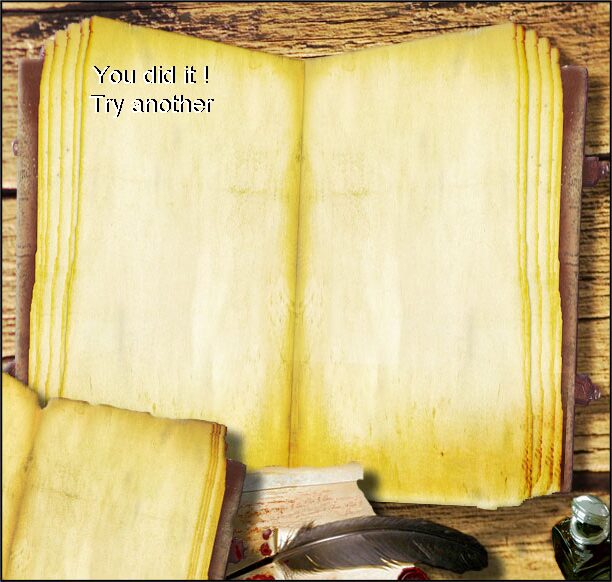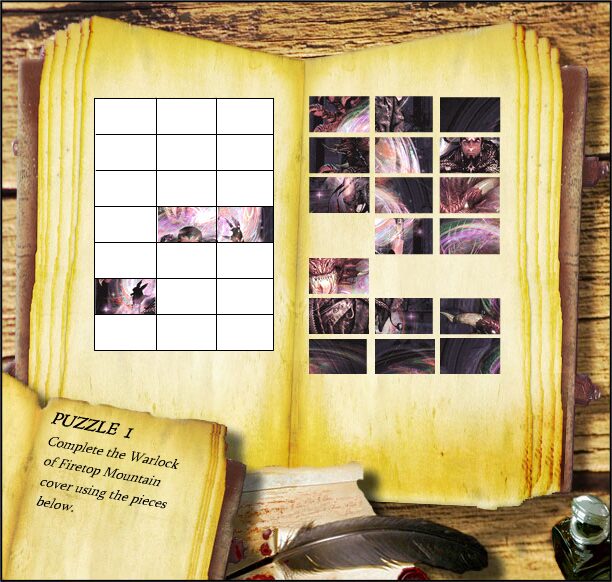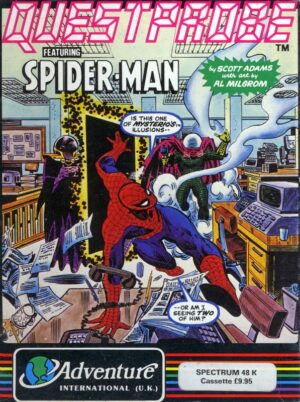Retro Replay Review
Gameplay
Fighting Fantasy Picture Puzzle transforms the classic mechanics of a jigsaw into a streamlined drag-and-drop experience. Players are presented with 21 equal rectangular segments of Martin McKenna’s iconic Warlock of Firetop Mountain cover illustration. The challenge lies in identifying the correct spatial relationships between fragmented artwork pieces and maneuvering them into place on a simple grid. Each correctly placed tile locks into position, offering a gratifying sense of progress as the larger image slowly materializes.
(HEY YOU!! We hope you enjoy! We try not to run ads. So basically, this is a very expensive hobby running this site. Please consider joining us for updates, forums, and more. Network w/ us to make some cash or friends while retro gaming, and you can win some free retro games for posting. Okay, carry on 👍)
The control scheme is immediately intuitive, whether you’re using a mouse or touchscreen. Tiles can be grabbed and moved without noticeable lag, and “snapping” into place feels precise rather than forced. For newcomers to picture puzzles, the game provides optional hints that highlight misplaced tiles or subtly outline where a selected piece should go. These aids ensure that frustration never outweighs fun, while purists can opt to turn off all assistance for a true brain-teaser.
Replayability is bolstered by adjustable difficulty settings. Beyond the standard 21-piece puzzle, players can choose smaller or larger grids—up to 49 segments—for a more painstaking reconstruction. Timed modes add urgency for speed-runners, and a “shuffle-and-switch” feature lets you mix multiple puzzles at once. Though the core loop is simple, these variations extend the life of the game far beyond a single playthrough.
Graphics
Central to the visual appeal of Fighting Fantasy Picture Puzzle is the high-resolution scan of Martin McKenna’s original cover art. Each tile captures the intricate detailing of the Wizard Books re-release: the flicker of torchlight on damp stone walls, the menacing silhouette of the Warlock’s fortress, and the textured armor of the adventuring hero. When assembled, the artwork almost jumps off the screen with the same dark, gothic tone McKenna intended.
The user interface remains unobtrusive, devoting nearly the entire screen to the puzzle itself. A subtle background gradient helps differentiate empty grid slots, and a minimal toolbar provides quick access to hint, shuffle, and zoom functions. Zooming in on individual tiles is smooth and lossless, ensuring that even microscopic brush strokes remain crisp. This attention to clarity aids in pattern recognition when searching for matching edges or color transitions.
Transition animations are simple yet polished. When a piece locks into its correct spot, a slight glow effect acknowledges your success. Swapping two misplaced tiles triggers a brief snap animation that feels tactile, reminiscent of physical puzzle pieces clicking together. These small touches elevate what could have been a mundane point-and-click interface into a more engaging visual experience.
Story
While Picture Puzzle does not feature dynamic dialogue or branching quests, it pays homage to the rich lore of the Fighting Fantasy universe. As you piece together Martin McKenna’s artwork, you’re effectively reconstructing a scene straight out of The Warlock of Firetop Mountain—your mental reward is revisiting a narrative fraught with danger and dark magic. Each tile unlocked reveals new story cues: skeletal remains hint at past adventurers’ failures, and the looming castle gate suggests hidden chambers within.
For longtime fans of the original gamebook, the act of reassembling the illustration carries its own nostalgia. You’re reminded of the perilous corridors you once navigated, the cunning traps you narrowly avoided, and the sense of dread as you drew closer to the Warlock himself. Newcomers who have never cracked open a Fighting Fantasy title will still appreciate the gothic fantasy setting, as the puzzle’s completed image tells a self-contained visual saga.
Though there’s no written narration within the title, each completed puzzle serves as a silent storyboard. You can almost imagine the next step—whether to storm the gates, delve into underground catacombs, or face the Warlock in a final showdown. This meta-narrative quality turns each play session into a contemplative experience, encouraging players to fill in the blanks with their own imagination.
Overall Experience
Fighting Fantasy Picture Puzzle strikes a fine balance between meditative puzzle-solving and evocative fantasy ambiance. It’s a low-stress way to engage with one of the genre’s most beloved illustrations, offering both a relaxing solo activity and a casual party challenge. The various difficulty levels make it accessible to puzzle rookies, yet there’s enough depth for seasoned veterans seeking a bigger test of spatial reasoning.
Performance is rock-solid across devices, from budget tablets to high-end gaming rigs. Load times are negligible, and you’ll rarely encounter graphical glitches or input lag. The hint system is well-implemented, providing incremental nudges rather than outright answers. If you’re someone who prefers to learn through trial and error, you can leave hints off entirely and rely on visual memory alone.
In summary, Fighting Fantasy Picture Puzzle is a must-have for puzzle enthusiasts and Fighting Fantasy aficionados alike. It revives Martin McKenna’s classic artwork in an interactive format that’s both challenging and satisfying. Whether you’re looking for a quick brain workout or an immersive way to revisit The Warlock of Firetop Mountain, this title delivers an engaging, art-centric experience that stands out in the crowded puzzle game market.
 Retro Replay Retro Replay gaming reviews, news, emulation, geek stuff and more!
Retro Replay Retro Replay gaming reviews, news, emulation, geek stuff and more!







Reviews
There are no reviews yet.